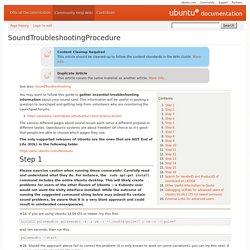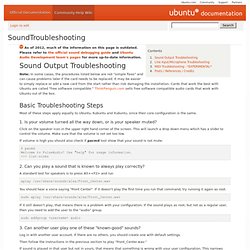

SoundTroubleshootingProcedure. See also: SoundTroubleshooting You may want to follow this guide to gather essential troubleshooting information about your sound card.

This information will be useful in posting a question to launchpad and getting help from volunteers who are monitoring the Launchpad forums: The various different pages about sound issues each serve a different purpose or different tastes. OpenSource systems are about freedom OF choice so it's good that people are able to choose which pages they use.
The only supported releases of Ubuntu are the ones that are NOT End of Life (EOL) in the following table: Please exercise caution when running these commands! #1A. Killall pulseaudio; pulseaudio -k ; rm -r ~/.config/pulse/* ; rm -r ~/.pulse* wait ten seconds, then run this: pulseaudio --start #1B. Killall pulseaudio; pulseaudio -k; rm -r ~/.config/pulse/* ; rm -r ~/.pulse* wait 10 seconds, then reboot (putting the machine to sleep is not enough -- fully power it off and then back on) . #1C. Reboot your computer. !! SoundTroubleshooting. As of 2012, much of the information on this page is outdated.

Please refer to the official sound debugging guide and Ubuntu Audio Development team's pages for more up-to-date information. Note: In some cases, the procedures listed below are not "simple fixes" and can cause problems later if the card needs to be replaced. It may be easier to simply replace or add a new card from the start rather than risk damaging the installation.
Cards that work the best with Ubuntu are called "free software compatible. " ThinkPenguin.com sells free software compatible audio cards that work with Ubuntu out of the box. Basic Troubleshooting Steps Most of these steps apply equally to Ubuntu, Kubuntu and Xubuntu, since their core configuration is the same. 1. Click on the speaker icon in the upper right hand corner of the screen. If volume is high you should also check if pacmd tool show that your sound is not mute: $ pacmd Welcome to PulseAudio! 2. A standard test for speakers is to press Alt+<F2> and run 3. Main Page - AlsaProject. How To Replace PulseAudio With ALSA Or OSS In A Few Seconds [Ubuntu Linux - GStreamer] ~ Web Upd8. I couldn't get PulseAudio to work on one of my computers no matter what I do.
![How To Replace PulseAudio With ALSA Or OSS In A Few Seconds [Ubuntu Linux - GStreamer] ~ Web Upd8](http://cdn.pearltrees.com/s/pic/th/replace-pulseaudio-gstreamer-5754766)
But removing PulseAudio can be tricky and besides, there is a very easy way to "fix" it (if you're using GStreamer as a backend for music and videos). This is very useful for applications which use GStreamer but do not let you select the sound output module like: Rhythmbox, Totem and so on. To use ALSA or OSS instead of PulseAudio for Gstreamer based apps, all you have to do is press ALT + F2 and enter: gconf-editor Then navigate to /system/gstreamer/0.10/default and change the "audiosink" and "musicaudiosink" to "alsasink" or "osssink", depending on what you want to use. If you want to do this via command line, all you have to do is paste this in a terminal: gconftool-2 --type string --set /system/gstreamer/0.10/default/audiosink "osssink"gconftool-2 --type string --set /system/gstreamer/0.10/default/musicaudiosink "osssink" The above 2 commands set GStreamer to use OSS for audio and video players.
AltFIRE.